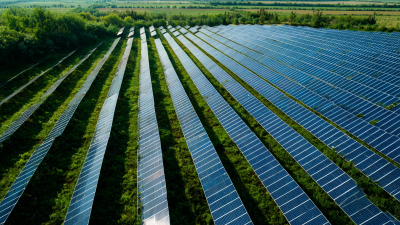
Blog
Innovative Green Energy Solutions for Sustainable Living in the Modern World
As the world grapples with the pressing challenges of climate change and diminishing fossil fuel reserves, the adoption of innovative green energy solutions has become crucial for sustainable living. According to the International Renewable Energy Agency (IRENA), renewable energy sources have the potential to meet up to 86% of global power demand by 2050, significantly reducing greenhouse gas emissions.
 In this context, advancements in solar, wind, and bioenergy technologies not only promise a cleaner energy future but also enhance energy security and economic resilience. Furthermore, a report from the Energy Information Administration (EIA) indicates that the U.S. alone could create nearly 1.3 million jobs in the renewable energy sector by 2030. This compelling landscape underscores the importance of integrating green energy solutions into our daily lives, paving the way for a more sustainable and prosperous future for generations to come.
In this context, advancements in solar, wind, and bioenergy technologies not only promise a cleaner energy future but also enhance energy security and economic resilience. Furthermore, a report from the Energy Information Administration (EIA) indicates that the U.S. alone could create nearly 1.3 million jobs in the renewable energy sector by 2030. This compelling landscape underscores the importance of integrating green energy solutions into our daily lives, paving the way for a more sustainable and prosperous future for generations to come.
Why Renewable Energy Sources Are Essential for Sustainable Living
Renewable energy sources are essential for sustainable living as they offer a viable solution to the growing demands for energy while minimizing environmental impact. The reliance on fossil fuels has led to significant climate change, air pollution, and depletion of natural resources. By harnessing renewable energy, such as solar, wind, and hydro power, we can reduce greenhouse gas emissions and combat these pressing issues. Transitioning to these energy sources aligns with the principles of sustainability, ensuring that future generations can enjoy a clean and healthy planet.
Moreover, renewable energy technologies are continually advancing, making them more accessible and efficient. Innovations in energy storage and smart grid systems enhance the reliability of renewable sources, allowing for their integration into existing infrastructures. As individuals and communities adopt these green solutions, they not only decrease their carbon footprint but also promote energy independence and economic resilience. As the modern world grapples with the consequences of climate change, embracing renewable energy is not just a choice but a necessity for sustainable living.
Innovative Green Energy Solutions for Sustainable Living in the Modern World
| Energy Source | Description | Benefits | Potential Applications |
|---|---|---|---|
| Solar Energy | Harnessing sunlight using photovoltaic cells or solar thermal systems. | Reduces electricity bills, low maintenance, and promotes energy independence. | Residential, commercial, and utility scale power generation. |
| Wind Energy | Utilizing wind turbines to convert wind energy into electricity. | Sustainable, abundant energy source with low operating costs. | Wind farms for large-scale electricity production. |
| Hydropower | Generating electricity by using the flow of water, typically in dams. | Reliable and efficient energy source with low emissions. | Electricity generation and irrigation systems. |
| Geothermal Energy | Using heat from the Earth's interior to generate steam for power generation. | Consistent energy source with small land and water footprints. | Electricity generation and direct heating applications. |
| Biomass Energy | Converting organic materials into energy through combustion or fermentation. | Reduces waste, supports rural economies, and can help with energy security. | Power generation, heating, and biofuels for transportation. |
Why Smart Technology Integration Enhances Energy Efficiency
The integration of smart technology into energy management is revolutionizing how we achieve energy efficiency and sustainability in modern living. The global artificial intelligence (AI) market for energy management is experiencing unprecedented demand as businesses and organizations strive to optimize energy usage, aiming to reduce operational costs and minimize environmental impacts. According to the latest reports, the energy management system market is projected to grow significantly, with a notable CAGR of 25.2%, reflecting an increasing focus on smart technology solutions for energy efficiency.
AI is becoming a cornerstone in clean energy technologies, profoundly transforming renewable energy deployment and grid operations. A recent report highlighted that by 2032, the global market for smart cities, which heavily incorporates AI and IoT technologies for energy management, is expected to expand from USD 629.9 billion in 2023 to an astounding USD 767.5 billion. This growth underscores the critical role that smart technology plays in achieving carbon neutrality and sustainable living. For instance, initiatives in countries like the UAE showcase how AI is instrumental in enhancing energy efficiency and accelerating the transition towards renewable energy resources.
Energy Efficiency of Innovative Green Solutions
This chart illustrates the energy efficiency benefits of various innovative green energy solutions integrated with smart technology. The data showcases the percentage of energy savings achieved through different methods.
Why Community Initiatives Drive the Adoption of Green Energy
Community initiatives play a pivotal role in the widespread adoption of green energy solutions. When neighborhoods come together to promote sustainable practices, they create an environment ripe for innovation and engagement. Initiatives such as community solar projects and local wind farms not only provide renewable energy sources but also foster a sense of ownership and responsibility among residents. This collective approach often leads to increased interest and investment in green technologies, demonstrating how communal efforts can drive substantial change.

Moreover, community-driven programs encourage education and awareness about the benefits of green energy. Workshops and informational sessions organized by local groups empower residents with the knowledge necessary to transition to sustainable practices. These efforts demystify green energy and showcase its practicality and cost-effectiveness. As individuals see their neighbors successfully implementing green solutions, they are more likely to follow suit, creating a positive feedback loop that amplifies the overall impact on sustainability within the community.
Why Education and Awareness Play a Crucial Role in Sustainable Practices
Education and awareness are pivotal in advancing sustainable practices in the modern world. As societies grapple with the pressing challenges of climate change and resource depletion, understanding the implications of individual and collective actions becomes essential. Informing communities about the existence and benefits of innovative green energy solutions, such as solar power, wind energy, and energy-efficient technologies, empowers them to make informed choices. Schools, universities, and community organizations can serve as vital platforms for distributing knowledge about sustainable practices, ultimately fostering a culture of environmental stewardship.
Moreover, the role of education extends beyond just imparting knowledge; it also inspires action. When individuals are made aware of the tangible impact their choices can have on the environment, they are more likely to adopt sustainable habits, whether it’s reducing energy consumption at home or participating in local conservation efforts. Awareness campaigns and educational programs can target various demographics, ensuring that all members of society understand the importance of sustainability. By equipping people with the necessary tools and information, we can create a community that not only appreciates but actively contributes to a sustainable future.
Why Government Policies Should Support Innovative Green Solutions
Government policies play a crucial role in fostering innovative green energy solutions that promote sustainable living. By providing financial incentives, such as tax credits and subsidies for renewable energy projects, governments can encourage both businesses and consumers to invest in clean technologies. These policies help to lower the financial barriers associated with adopting green energy solutions, making it more accessible for everyone. Additionally, government grants for research and development can stimulate groundbreaking innovations in energy efficiency and sustainable resources, paving the way for a greener future.

Moreover, regulatory frameworks that favor renewable energy can drive significant changes in the energy landscape. By setting ambitious targets for carbon reduction and establishing renewable energy standards, governments can create a competitive environment that promotes innovation. Such policies motivate companies to develop cleaner technologies and practices while also fostering collaboration between the private sector and research institutions. This synergy not only enhances the local economy but also positions nations as leaders in the global transition to sustainable energy, benefiting the planet and future generations.
Related Posts
-

Innovative Green Energy Alternatives Shaping the Future of 2025 Technology Trends
-

Navigating the Future of Best Sustainable Energy Solutions in 2025 with Practical How to Strategies
-

Comparing Top Green Energy Solutions for Sustainable Business Practices
-

Top Strategies for Sourcing the Best Green Energy Solutions in a Competitive Market
-

Evaluating the Ecological Benefits of Green Power vs Traditional Energy Sources: A Comprehensive Comparison
-

The Future of Solar Energy Solutions How Innovative Technologies Are Shaping a Sustainable Tomorrow